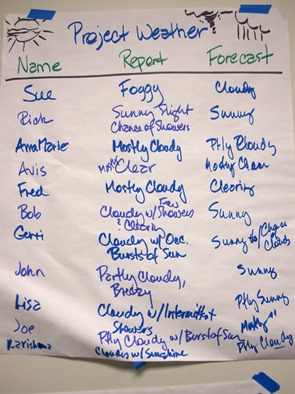Add "Project Weather" to your retrospective design to both "Set the Stage" and "Close the Retrospective". As an opening, it provides a useful segue into creating a shared story and begins the process of gathering data. As a closing, it illustrates any shifts in team members' perspectives that have occurred as a result of their collaboration in the retrospective.
To Prepare:
Create a pre-drawn flip chart with a heading at the top: Project Weather. Add hand drawn graphics across the top, like a sun coming out from behind clouds, clouds and rain, or even the occasional tornado! Divide the flip chart portion below the title into three columns: Name, Weather Report, and Weather Forecast. See the example below.
To Set the Stage:
An introduction for Project Weather goes something like this,
"Every environment has a climate, and we experience climate change from time to time. Thinking back over the metaphorical climate of recent iteration, how would you characterize the "weather" you experienced? Using only one or a few words, how would your local TV meteorologist describe it? Who will start?"
A hand goes up or someone speaks up, and we begin. Since just about everyone is familiar with the terminology of weather reports in the media, you’ll almost never have to give further examples. People know this metaphor well.
As you go around the circle (or around the room), write each person's name and their "weather report" comment. Ask every team member for their contribution. This serves to set a tone that we expect everyone to participate during the meeting. Keep the written record because we'll come back to it later in the wrap-up. When everyone has offered their report, ask for volunteers to give a few brief overview comments on what they see as the commonalities and variances in the reports.
Then move the group into whatever more extensive activity(ies) you’ve planned for the Gather Data step, such as Timeline, FRIM, Team Radar, etc.
To Close the Retrospective:
After the team has learned about their shared story and collective data for the iteration; thought together to analyze what it means for them and the implications for their upcoming work; and made a joint decision about what improvement action or experiment to try next time, it's time to bring the retrospective to a close.
As the retrospective leader, return to the Project Weather flip chart. This time reintroduce it and ask for a weather forecast,
"Earlier you all reported the weather for last iteration. Given the work you've done together in this retrospective, and your plans for improving, let's go around again and see what you each forecast for the next iteration. Again, in just one or a few words, use the terms you'd hear on a TV news cast."
Starting down the list of names in the same order, write down the "forecasts." Ask, "How does this look the same or different from our earlier reports?" Take only a couple of comments, before moving to whatever activity you have planned for getting feedback on the retrospective. (For an example of a completed Project Weather flip chart, see photo below.)

Overview:
As a quick group process activity, Project Weather provides useful "bookends" for the retrospective, and sets it apart from the meetings that often come just before and just after - Iteration Demo/Product Review and Iteration Planning. It also injects a sense of playfulness and creativity into the process. We've shared it with many teams, and, so far, it's been well-accepted by everyone.
Acknowledgement: The core idea for this activity came originally from Jutta Eckstein at the 2006 Retrospective Facilitators Gathering in Baden-Baden, Germany.